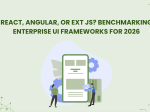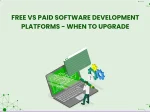Selecting the Ideal Web Application Framework: A Comprehensive Guide
Get a summary of this article:

Front-end development has evolved significantly — users now expect apps to feel smooth, fast, and intuitive. Businesses, on the other hand, want applications that not only look great but also work seamlessly across every device and screen size. Using the right cross-platform software development approach ensures your web and mobile applications run seamlessly across devices while maintaining speed, consistency, and scalability.
That’s where using the right tools and following solid development practices come into play. If you’re diving into web and app development — especially front-end and back-end app development — you can’t ignore the impact of frameworks like Ext JS.
Ext JS is considered one of the best mobile app frameworks for enterprise, enabling businesses to build scalable, high-performance apps with ease. Known for its robustness, Ext JS is built for cross-platform mobile app development and web application development. It’s tailored for developers who need to move fast without breaking things.
With so many choices out there for application development software. Especially in web app development, it’s easy to get lost. The key is consistency, code quality, and smart architecture.
This blog focuses on front-end strategies, particularly with Ext JS, that promote maintainability, performance, and scalability. We’ll also explore how cross platform mobile programming fits into this equation, and why app software development needs careful planning.
If you want to build fast and keep things running smoothly as you grow, stick with the basics. Doesn’t matter if it’s a huge platform or a simple app; they still apply. Let’s dive in.
What Is Ext JS and Why Use It?
Ext JS, which is an Extended JavaScript framework, is a powerful framework made for serious front-end development. It’s designed to handle large applications, especially in business and enterprise settings. What sets it apart is its structured approach, strong architecture, and a complete set of built-in tools.
It supports both MVC and MVVM patterns, which help organize your code and keep your logic clean. It makes teamwork easier and cuts down the headache of maintaining stuff. If you’re building for multiple platforms, Ext JS gives you a rock-solid base to start from.
The framework offers extensive ready-to-use components, such as forms, grids, and charts. In addition to customising themes and making sure your layout is compatible with all browsers and screen sizes, you can connect data directly to UI elements.
Ext JS also performs well with large data sets, making it ideal for dashboard-style applications. So if you’re serious about website and app development, this framework helps you build fast, stay consistent, and scale with confidence.
1. Stick to Modular Architecture
Modular code is easier to debug, test, and scale. In Ext JS, take advantage of MVC and MVVM architectures. Separate concerns early: models handle data, views handle layout, and controllers manage interaction.
Divide your app into self-contained modules with well-defined responsibilities. Avoid monolithic logic files. Think of your modules like building blocks that plug together seamlessly.
This approach benefits all forms of app development software, from simple dashboards to complex cross platform app development services. It also makes onboarding new developers easier, since each module is easier to understand. Version control becomes cleaner, and future refactoring takes less time.
2. Use the Component Library to the Fullest
Ext JS ships with a mature set of UI components. Grids, buttons, toolbars, date pickers, they’re all battle-tested. Instead of creating custom components from scratch, extend existing ones.
This improves code consistency and reduces the chance of bugs. Every component follows a unified theming model, which also makes styling easier. Want to reuse the same structure in your cross platform mobile application development? It’s built for that.
Not only does this speed up website and app development, but it also reduces future tech debt. You can maintain a consistent user experience across different screens while cutting down on repetitive code.
3. Embrace Strong Typing and Data Binding
Data binding keeps your UI and model in sync with minimal code. Ext JS, which is an Extended JavaScript Framework, supports one-way and two-way binding. Combine it with strong typing in models to catch issues early.
Define your models clearly using Ext.data.Model. This structure makes it easier to track changes, validate input, and sync data. Whether you’re doing cross platform mobile app development or building for desktop, this consistency matters.
You’ll appreciate this when maintaining large-scale apps. Strong typing also helps with code suggestions in IDEs and reduces debugging time. Especially when working with complex data structures or API responses.
4. Prioritize Responsive Design from the Start
Don’t treat responsiveness as an afterthought. Ext JS supports responsive layouts, but you still need to design for varying screen sizes from the beginning. Use flexible containers, fit layouts, and percentage widths.
Think about breakpoints for tablets and phones. Test regularly on different viewports. When building a cross platform mobile programming solution, modify visual styles early for better responsiveness and to save refactoring time later.
It’s critical for front end app development when aiming for maximum reach. A responsive layout improves usability, reduces bounce rates, and ensures accessibility for users across devices and screen resolutions.
5. Optimize Performance Thoughtfully
Performance isn’t just about page speed. It’s also about how smooth everything feels. Lazy-load non-critical modules. Use the Ext. require system wisely to include only needed resources.
Images and assets should be compressed. Use CDN delivery where possible. Minimize DOM manipulation to reduce repaint costs.
If your project is part of a larger front end and back end app development workflow, optimizing load time impacts user retention. Tools like Lighthouse or WebPageTest can help you pinpoint bottlenecks and make measurable improvements.
6. Leverage Testing and Automation Early
Manual testing gets tedious fast. With tools like Sencha Test, you can automate unit and functional tests. Validate UI states, simulate clicks, and test multiple browsers automatically.
For continuous delivery pipelines, use Git and Jenkins with pre-deployment test suites. This ensures your website application development remains stable as your team grows.
Testing is an essential part of app software development platform that often gets ignored until it’s too late. Writing tests alongside your features builds confidence, catches bugs early, and helps ensure every release is reliable.
7. Build and Deploy Smartly
Don’t ship raw code. Use Sencha Cmd to minify, bundle, and optimize builds. Pair it with the best application development software to streamline workflows. Create separate builds for development, staging, and production.
Use GZIP and cache-control headers for delivery. Set up build scripts to automate your deployment process. If your business offers cross platform app development services, these steps build trust and reliability.
Combine this with analytics, error tracking, and regular patch updates for real-world stability. A smart deployment strategy saves time, reduces rollback stress, and ensures your app is production-ready every time.
Setting Up the Ext JS Development Environment
Choose a reliable code editor and test on multiple browsers to keep things smooth and compatible.
Download the Library:
Go to Sencha and request a free trial. You’ll get a ZIP file. Typically named ext-6.0.1-trial.zip, via email.
Once downloaded, store it in your project folder for quick access. This file includes all necessary Ext JS resources such as JavaScript, CSS, and theme files. It’s the foundation you’ll need to begin building.
If you’re ready to get started, click here to download the free trial.
Extract & Include Files:
After unzipping the folder, open it up and check out what’s inside. You’ll mostly need the main JavaScript and CSS files sitting in the build/classic folder. That’s where the essentials are.
The following code helps to link the Ext JS framework with your project. Just insert these lines of code in the HTMLtag.
<head>
<link rel="stylesheet" type="text/css" href="../ext-6.0.1-trial/build/classic/theme-classic/resources/theme-classic-all.css" />
<script type="text/javascript" src="../ext-6.0.1-trial/build/ext-all.js"></script>
<script type="text/javascript" src="app.js"></script>
</head>This setup ensures your project loads the necessary assets when the page runs.
CDN Option:
CDNs allow you to directly use them without going through a downloading step. Just grab the CDN links below and paste them into your HTML. It’s an easy way to get started.
It really saves time and bandwidth by loading the core CSS and JS files directly from the CDN.
<head>
<link rel="stylesheet" type="text/css" href="https://cdnjs.cloudflare.com/ajax/libs/extjs/6.0.0/classic/theme-crisp/resources/theme-crisp-all.css" />
<script type="text/javascript" src="https://cdnjs.cloudflare.com/ajax/libs/extjs/6.0.0/ext-all.js"></script>
<script type="text/javascript" src="app.js"></script>
</head>This method is great for testing or small projects without a local setup.
Recommended Editors:
To write and manage your Ext JS code efficiently, choose a flexible code editor. Sublime Text, Notepad++, and Eclipse are solid options.
You should try Visual Studio Code for a better development experience. Its excellent extensions, IntelliSense, and Git integration help to expedite the process.
Supported Browsers:
Ext JS works across all major browsers. It supports Chrome 10+, Firefox 3.6+, Safari 4+, Internet Explorer 6+, and Opera 11+.
It’s better to check the app’s consistency across different browsers. This enhances the performance. One of the best things about Ext JS, particularly in business settings, is its cross-browser compatibility.
Also Read: Top Low-Code Platforms for Rapid Web App Development
Working with Ext JS Models and Stores
In Ext JS, models and stores handle the data side of things. They make it easier to pull in info, link it up, and show it cleanly in your UI.
You’ll often define a model, then feed it into a store. The store can be static or dynamic depending on your app’s needs, especially when building a rapid web app for faster deployment.
Model Example:
Simply said, a model is a roadmap for your data. Here, we’re creating a straightforward one with three fields for student data.
You can map each field to backend data properties during runtime while maintaining view and data synchronisation.
Ext.define('StudentDataModel', {
extend: 'Ext.data.Model',
fields: [
{name: 'name', mapping: 'name'},
{name: 'age', mapping: 'age'},
{name: 'marks', mapping: 'marks'}
]
});Static Store Example:
Static store’s just you dropping in some data by hand. Super useful when you’re testing stuff or don’t need to bother with an API or Application Programming Interface.
Here, the student data is baked right into the code. There’s no server involved. It simply loads straight into the UI without doing anything fancy.
Ext.create('Ext.data.Store', {
model: 'StudentDataModel',
data: [
{ name: 'Rahul', age: '16', marks: '90' },
{ name: 'Akshay', age: '18', marks: '95' },
{ name: 'Nandni', age: '20', marks: '68' }
]
});Dynamic Store with Proxy:
Dynamic stores fetch data from external sources like APIs. You use a proxy to define how and where to retrieve the data.
In this example, the store pulls student data from a JSON file using Ajax.
proxy: {
type: 'ajax',
url: 'data.json',
reader: {
type: 'json',
rootProperty: 'students'
}
}Conclusion
Getting good at front-end development with Ext JS is more than just learning the framework. It’s more about a great choice in structure and web design. Performance and user experience should guide every step.
Ext JS helps you build apps that don’t fall apart as they get bigger. The ready-made parts and solid data handling just make life easier. You spend less time fixing bugs. Your app functions properly on all devices when it has a responsive design.
Add in testing, automation, and clean deployment workflows. This helps keep your code reliable and easy to maintain. It also makes releasing updates much smoother.
In the current cross-platform mobile app development environment, efficiency is crucial. With minimal effort, you wish to construct once and deliver everywhere. Using these recommended practices will help you arrive more quickly and with less anxiety.
FAQs
What Is Front-End Development in an App Project?
It refers to designing and coding the parts of the app users interact with, including UI components, navigation, and responsiveness for different screens.
What Is a JavaScript Framework?
It provides a built-in structure that helps developers build an app efficiently. This can save costs and time. Ext JS, React, and Angular are a few examples.
What Is a JavaScript Library?
A JavaScript library helps to simplify the complex work during the building process. It is a collection of reusable components and functions like jQuery or D3.js.
What Are Frameworks in Web Development?
These are structured platforms or toolkits that help streamline website and app development with reusable code patterns, layouts, and logic handlers.
What Is the Google Services Framework Used For?
It’s part of Android that supports background services and syncing with Google accounts like Gmail, Contacts, and the Play Store.
What Are Software Tools?
Software tools include editors, debuggers, version control systems, and compilers that help build, test, and maintain applications.
What Are Software Development Tools?
These include frameworks, APIs, IDEs, and automation tools that aid developers throughout the app development lifecycle from coding to deployment.
What Is Cross-Platform Software Development?
It means building apps that run on multiple platforms like iOS, Android, and web, using one codebase or shared logic.
What Is the Best Low-Code Platform?
Platforms like OutSystems, Mendix, and Microsoft Power Apps are popular low-code solutions for quickly building business apps without deep coding skills.
What Is the Best Way to Build an App?
Start with a solid plan, choose the right tools or frameworks, keep your code modular, test regularly, and focus on user experience across all devices.
Experience the Power of Ext JS and Build Stunning Web Applications Today!

For Independent Software Vendors operating in competitive global markets, the user interface has evolved from…

The selection of a front end framework for enterprise applications remains one of the most…

Every software project begins with a choice that reverberates through its entire lifecycle: which development…









